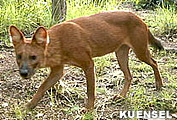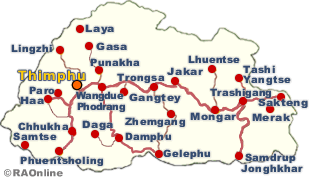|
Bhutan's
Nature - Animals
|
 |
Bhutan's
Nature: Animals - Wild Dogs |
|
 |
 
|
Wild dog: Making a comeback
|
 |
|
Wildlife Predation: Wild dogs top the list of predators, preying on livestock, in almost all parts of the country.
This was one of the findings of the forests and park services officials, following their research on human-wildlife conflicts across the country.
|
|
 |
|
Wild dog predation, forest and park services officials said, was on a steady rise, where attacks on livestock were reported mostly during the winter season, the packs normally preferring yak, its calves and horses.
A finding in Toorsa nature reserve that covers Katsho, Eusu and Bji gewogs in Haa, and Sangbay gewog in Samtse, comprising 697 households, shows that more than 50 percent of all attacks on livestock were attributable to wild dogs.
|
|
Farmers reported frequent attacks on yaks by wild dogs in packs of three to 15. The four gewogs in total have more than 200 yaks. Often mistaken for a fox and feared by farmers for its aggressive nature, the wild dog has a fox-like snout with long dark whiskers, reddish fur with brownish highlights along the top of the head, neck and shoulders.
Cattle and other domestic animals that are left free in the forest to graze are easy victims for these wild dogs, and farmers had reported that, when they tried shooing the wild dogs away, they were snarled at and had to retreat for safety.
Young wild dogs measure only two feet long, standing 14 inches high with the throat, chest, flanks, belly and the upper parts of the limbs usually dull in colour and are more yellowish in tone. The lower parts of the limbs are whitish, with dark brownish bands on the anterior sides of the forelimbs.The tail is very luxuriant and fluffy, and is mainly of a reddish colour, with a dark brown tip.The summer coat is shorter, coarser and darker.
Wild dogs are found in almost all parts of the country.
Forest and park services officials said wild dogs were more transient and frequently travelled over large distances; their home ranges overlapping with those of tigers and leopards.
"But they rarely come in conflict with the other predators, due to their fleeting presence in a particular area," an officials said. "They were known to kill leopards and even tigers if the pack is big."
Forest officials also said livestock predation by wild dogs was a problem in Bhutan since the late 90's, as domestic animals were often left outside to freely graze in the forests, sometimes for weeks at a time.
Once it catches a prey, wild dogs normally attack the eyes to blind its prey. It does not use the killing bite to the throat like big cats. Since there is no compensation for farmers losing their livestock to wild dogs, as is the case about those lost to other big cats, all forest officials can do is advise farmers to not allow their cattle to graze free in the forest, or to at least attend to their livestock while grazing.
Farmers concocted their own measures.
More than a decade ago, a mass poisoning of wild dogs using rat poison was carried out in lower Kheng region in Zhemgang as a defense against the wild dogs.
While that strategy worked in keeping the wild dogs at bay for a while, the killing of livestock by the predator pack continued, although not as rampant.Besides, their initial strategy invited the wild boar horde that devastated fields of crops.
Conservation officials said that, with many wild dogs harming livestock in the country, they were instructed to kill all wild dogs in the past, but that was not a solution to the problem. "Instead it invited a bigger problem through drastic increase in wild boars," a conservationist said. "There was imbalance in the ecosystem, because of the killing of wild dogs, and wild boar became a bigger problem."
About 37 percent of wild dogs preyed on domestic animals, such as cattle and horse, the remaining 63 percent comprised other wildlife, wild boars being it preferred prey. Having learnt of the imbalance poisoning of wild dogs caused, farmers changed their strategy, by changing their animal herding behaviour, employing full time cattle herders and stabling horses and mules at night.
Some farmers complained that, although such changes reduced loss of livestock to wild dogs, employing full time cattle herder was an additional burden to their already strained manpower.
The study further stated that, in Bardo and Nangkor gewogs of Zhemgang, wild dog densities were highest in Langdurbi village, where at least three packs, comprising between seven and 14 wild dogs, were reported. Farmers reported loss of more than 70 livestock, mostly cattle and a few horses.In one incident, farmers told of how wild dogs came right up to the doorstep and killed a pig.
Management plans, wildlife conservationists said, included initiating crop and livestock loss mitigation strategies in pilot villages with community-based livestock, and crop insurance or compensation schemes in worst affected areas.

|
| This
article was contributed by Passang Norbu, KUENSEL, Bhutan's National Newspaper,
2012 |
top
|
more information
|
 |
|




